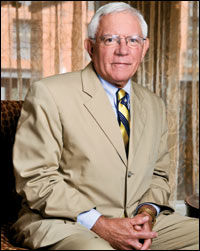
The National Fire Protection Association recently elected a new chair of their board of Directors, Tom Jaeger, 67, who has spent his career in the health care industry. In an interview posted on the NFPA site, Mr. Jaeger said he envisions the organization becoming more involved in wildfire.
Also, a goal we established last year is to get more involved with the issue of wildfires. It’s an area that NFPA has rallied behind, but we also recognize that we need to get more involved. NFPA’s done a very good job at getting its name out there in relation to wildland fire issues, especially through the Firewise program, and it’s something we can do even more of through public education. I come from the technical side of NFPA, and I’m learning every day about the organization’s array of education efforts.

CAL FIRE does indeed follow the requirements of Cal-OSHA as stated by Dick. Unlike (fed) OSHA though, Cal-OSHA actually has some teeth and regularly levies severe fines to agencies, and in some cases, recommends criminal prosecution to local DAs for individuals.
If you look at the Cal-OSHA rules and regulations, you will notice that they’ve “incorporated by reference” the NFPA consensus standards. By such, CAL FIRE is meeting both legally mandated standards and NFPA recommendations.
The USFS has several individuals as key members on many NFPA committees that are either directly relating to wildfire (ie- wildland PPE standards, wildland respiratory protection standards, wildland training standards, etc.)
Like the partnerships in the past, they are all field level and from individuals “volunteering” for service.
I’m very happy to see some of the leaders from SDTDC, MTDC, USFS Risk Management, and the NWCG Risk Management Committee serving on these standards reviews with their peers and experts from other agencies.
It’s important to understand all of the “ins and outs” of NFPA: they are officially a “non-profit” organization that’s primary mission is fire safety, through the establishment of their Standards program.
I was the 1st Chair of the NFPA 1977 Standard on “Protective Clothing and Equipment for Wildland Firefighters”. It was called a “consensus Standard”. meaning that it was agreed to by a Committee represented by nine (9) different interest groups, including users, manufacturers, labor unions, test labs, technical specialists, enforcement agencies (like OSHA), etc. Everyone had an equal vote at the table for the final Standard. Some of the folks that had votes on the Committee would not have recognized a wildfire if it had been burning their butts; hopefully, the wildfire folks on the Committee are able to help them see reality?
As I understand it, the current Technical Committee Chair is an employee of CalFire, an organization that does NOT adhere to NFPA standards, instead using the CalOSHA standard – I may be mistaken. If it is in fact the case, it seems like “do as I say, not as I do”.
NFPA has done well with the FireWise Program, largely with a large influx of Federal $$ from the member Agencies of NWGC; Jim and Cheryl from FireWise have done a great job passing the message about fire safety in the WUI, and desreve the thanks of wildland fire folks.
But for me, the bottom line is that wildland fire is just a tiny bleep on the NFPA radar. Those of us in the wildland fire world should stay connected with the NFPA folks, but not count on them to provide serious leadership in our area.
Also, like Bill’s earlier articles on IAFC, lots of the funding for the NFPA wildland efforts seems to come from the Feds with wildfire responsibilities.
When I first became involved with the NFPA process as a USFS employee in the early 1990’s, the National leadership discouraged our participation. My feedback to them was that “NFPA is like a large aircraft carrier: it’s hard to change it’s direction, but you cannot do it if you are not on-board!”
Why is the head of a fire board from the health care industry?